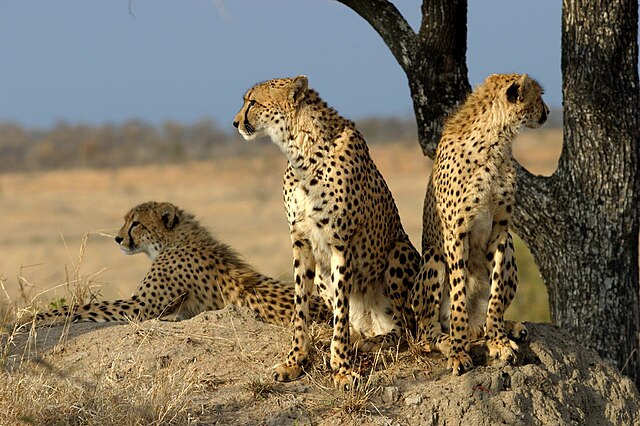species of mammal From Wikipedia, the free encyclopedia
A cheetah (Acinonyx jubatus) is a medium large cat which lives in Africa and Asia. It is the fastest land animal and can run up to 75 miles (121 km) per hour, and accelerate from 0 to 60 miles per hour in less than 3 seconds.[2][3] Most cheetahs live in the savannas of Africa. There are a few in Iran. Cheetahs are active during the day, and hunt in the early morning or late evening.
| Cheetah Temporal range: Pleistocene–Holocene, 1.9 mya–present | |
|---|---|
 | |
| Female Southern African cheetah KwaZulu Natal, South Africa | |
| Acoustic repertoire of cheetahs | |
| Scientific classification | |
| Domain: | Eukaryota |
| Kingdom: | Animalia |
| Phylum: | Chordata |
| Class: | Mammalia |
| Order: | Carnivora |
| Suborder: | Feliformia |
| Family: | Felidae |
| Subfamily: | Felinae |
| Genus: | Acinonyx |
| Species: | A. jubatus |
| Binomial name | |
| Acinonyx jubatus (Schreber, 1775) | |
| Subspecies | |
| |
 | |
| The range of the cheetah
Former range
Low density
Medium density
High density | |



The cheetah compared to other big cats is light and slimly built. Its long thin legs and long spotted tail are necessary for fast running.[4] Its lightly built, thin form is in sharp contrast with the robust build of other big cats. The head-and-body length ranges from 112–150 centimetres (44–59 in).[4] The cheetah stands 70 to 90 cm at the shoulder, and weighs 21–72 kilograms (46–159 lb).[4][5]
The slightly curved claws are only weakly retractable (semi-retractable).[4] This is a major point of difference between the cheetah and the other big cats, which have fully retractable claws.
Cheetahs are active during the day, and hunt in the early morning or late evening. Cheetahs are carnivores. They prey on Thomson's gazelle, impala, gerenuk, Grant's gazelles, Speke's gazelles, greater kudus, springbok, red hartebeest, puku, oribi, steenbok, elands, blue wildebeest, Grevy's zebras, Grant’s zebras, warthogs, hares, ostrichs, and even kills hunting prey.
When the cheetah hunts, it slowly and secretly moves toward its prey. When it is close to the prey (about 10–30 meters), it runs after it very quickly. Cheetahs kill their prey by tripping it during the chase. To kill medium- to large-sized prey, the cheetah bites the prey's throat to suffocate it to death. A bite on the back of the neck or the snout is enough to kill smaller prey.[6]
The cheetah cannot defend itself against lions or hyenas who would take the cheetah's prey away. The prey is taken to a shaded place. The cheetah, exhausted after the chase, rests beside the attack and pants heavily for some time. Once they recover, cheetahs eat quickly, and consume large quantities as soon as they can.
Pregnant females give birth to about 3 to 5 cubs or kittens after three months pregnancy. It takes two years of full-time supervision by the mother before the cubs are ready to live independent lives. They need to learn how to catch prey, and that takes time. The young are vulnerable to larger predators: lions especially try to kill cheetahs.
The cheetah has unusually low genetic variability and a very low sperm count. Their sperms also suffer from deformed flagellae, and so their movement is damaged.[7] Apparently, cheetahs went through a great reduction in numbers during the last ice age. Inbreeding after the event further reduced the variation (genetic drift).
Due to the fact that cheetahs never attack and kill humans they were extremely popular as hunting pets since antiquity and especially in medieval times in the Near and Middle East.
In modern times, cheetahs probably are the most difficult wilds cats to have as pets, due to the necessity for wide open spaces for cheetah for them to run at full speed . It's very important to feed them properly, because cheetahs in captivity must eat only lean steamed meat so they do not get sick and perish.
The cheetah is the fastest land dweller. The acceleration of a cheetah allows it to reach speeds of up to a hundred kilometers per hour in three seconds (its maximum speed is 112 kilometers per hour). The speed that a cheetah can develop from the start in three seconds cannot be matched by any sports racing car.[8]
The nearest challenge to the cheetah's speed comes from the pronghorn and springbok.
Seamless Wikipedia browsing. On steroids.
Every time you click a link to Wikipedia, Wiktionary or Wikiquote in your browser's search results, it will show the modern Wikiwand interface.
Wikiwand extension is a five stars, simple, with minimum permission required to keep your browsing private, safe and transparent.